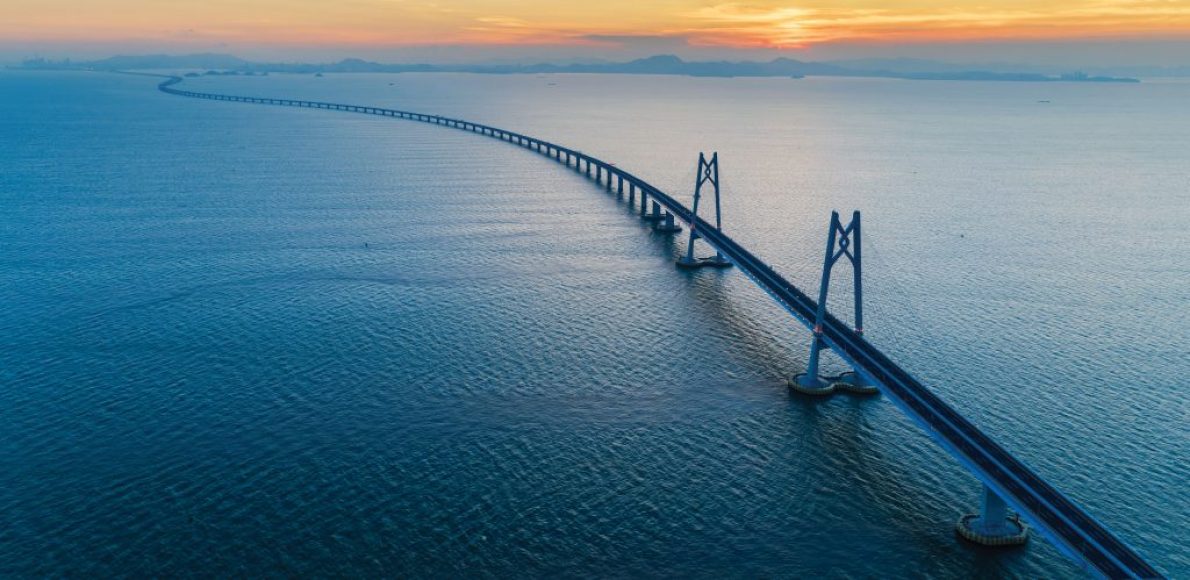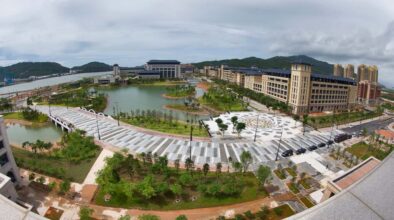TEXT Cláudia Aranda
New transport infrastructures are crucial for Macao’s future development and positioning within the Greater Bay Area. We investigate the bridge, tunnel, LRT and airport projects in the pipeline and discover how these ambitious schemes will transform the city.
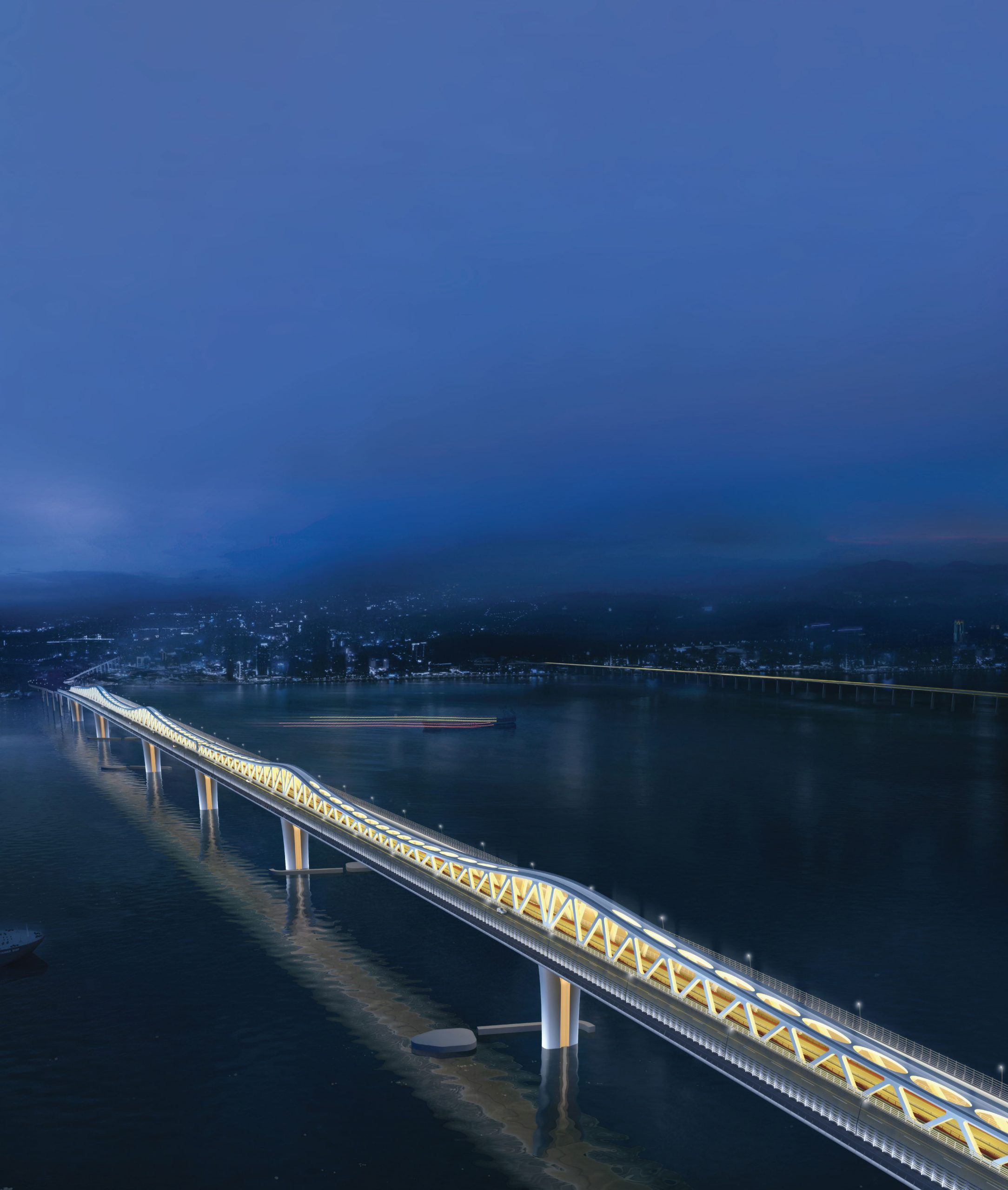
In October 2018, one of the biggest transport infrastructure projects in Macao’s history was completed to great fanfare. The 55-kilometre Hong Kong-Zhuhai-Macao Bridge (HZMB) – the world’s largest sea crossing – was opened and the city entered a new dawn of easier travel to its sister SAR and to China’s Mainland. A year later, the Macao Light Rapid Transit (LRT) system – the first rapid transit system in the territory – opened and, despite being far from complete just yet, this new mode of travel around the city was also welcomed by locals. But even these milestone projects are just the tip of the iceberg.
There are many more improvements to Macao’s transport infrastructure that are due to happen over the coming years. These projects will further boost the freedom of movement around the city and they will certainly help Macao to further integrate with the Greater Bay Area (GBA) and beyond. Experts agree that these plans are crucial for Macao’s future development, growth and positioning within the GBA.
Macao has several transport infrastructure projects underway or in their beginning stages that are expected to change the territory’s scenery. That includes a fourth bridge and an underwater tunnel between Macao and Taipa, as well as the extension of the LRT, a new tunnel linking Cotai to Ka Ho in Coloane and the expansion of the Macao International Airport (MIA) at the eastern end of Taipa Island. With the underwater tunnel, Macao will have five connections between the peninsula and Taipa Island – there are also flyovers, expressways and other tunnels in the pipeline across the city. These are projects that are expected to serve an increasing number of locals and visitors and will link the peninsula to new residential areas on new reclaimed land zones, as well as reducing traffic congestion across the city.
The aim is also to better connect the territory with the GBA, a megalopolis which consists of nine cities on the Mainland as well as the Macao and Hong Kong SARs and is expected to have a combined population of around 100 million in the near future. The GBA project aims to foster growth by further developing technology and innovation, boosting infrastructure and increasing financial links between the cities. And, for Macao, these transport infrastructure improvements will go a long way to helping the SAR better connect with the GBA.
On 20 April, Macao Chief Executive Ho Iat Seng gave his 2020 policy address before the Legislative Assembly, also discussing the measures that the city is taking to revitalise the economy following the hit it took during the coronavirus pandemic. Shortly afterwards, the government announced that it intends to take a raft of measures in order to promote this revitalisation, including increasing its public investment in infrastructure, particularly in relation to urban transport projects, as well as schemes surrounding public housing and government facilities. The need to expedite public construction projects to create job opportunities was highlighted as part of these measures, as was the need to both commence construction of the fourth Macao-Taipa cross-harbour bridge and to expedite the construction of the LRT system.
Challenges and opportunities

“The connection of Macao to the Mainland and especially to the Greater Bay Area,” says Joe Eddie Wu Chou Kit, legislator and chairman of The Macau Institution of Engineers, “will lead to mutual benefits in the future development of these regions.” Time is of great importance to Wu and he expects many transport infrastructure schemes will be completed in Macao over the coming decade. “The infrastructure projects,” he says, “especially the LRT, the bridges and even the highways, expressways and the expansion of the international airport, are all projects that Macao must complete in the next five to 10 years.”
Over the coming years, Macao is expanding to new reclaimed areas of land in the city in a move that was given approval by the central government in December 2009. These strips, known as the Macao New Urban Zone and making up a total area of 3.5 square kilometres – or 350 hectares – of land reclaimed from the sea, are divided into five sections. As they are being created, there is a real need to implement the connections between them and the existing Macao peninsula.
Zone A, a 1.38-square kilometre area near the Outer Harbour Ferry Terminal and the HZMB checkpoint, is expected to hold some 32,000 housing units, with 28,000 of them to be used for public housing. Zone B, with its 0.47 square kilometres in the south of peninsula that’s split into two lots separated by the Governor Nobre de Carvalho Bridge, is designed for public facilities and green areas. Zones C and D, which are 0.33 and 0.59 square kilometres, respectively, will focus on housing and commercial areas in the northern part of Taipa Island, while the 0.73-square kilometre Zone E, also split into two lots next to the airport and the Pac On ferry terminal, will be for public infrastructure, with a focus on transportation, housing, commercial and industrial areas.

“These infrastructures,” says engineer Tiago Pereira, an advisor to the Civil Engineering Laboratory of Macau (LECM) and a territory representative within the relatively new Association for Co-operation and Development Portugal – Greater Bay Area, “will introduce profound changes in Macao’s transportation network.” He says that the new reclaimed areas make up ‘an urban development plan that aims to solve the problem of presently overpopulated areas, namely in the north of Macao, allowing the construction of public housing and the expansion of commercial, green and administrative areas’. Pereira adds that this plan will ‘significantly alter the distribution of the population’ throughout the territory and, as a result, it will also alter ‘mobility patterns’.
Reinforcing connectivity
Pereira predicts that ‘the fourth and fifth connections between Macao and Taipa will further reinforce connectivity and transport network redundancy by offering additional alternatives between Macao and Taipa, Cotai and Coloane’. Also, he says the Macao Light Rail Transit system ‘will play an important role in the internal mobility of the city by offering an attractive public transportation alternative’.
These projects ‘by their very nature represent a huge financial investment and are technically complex’, according to Pereira. He says that the fourth and fifth connections between Macao and Taipa are ‘most notably’ expensive and complex. The six-lane, 2.4-kilometre-long tunnel built in soft soil ‘introduces new challenges as it is the first of this size in Macao’, explains the advisor to the LECM. He also explains that the role of the laboratory is ‘to fully support the Macao government in every way possible’ so that there will be a ‘successful completion of these projects’. The LECM has been in charge of quality control for projects like the LRT, the Ka Ho Tunnel and the new land reclamation areas – plus, it is currently involved in the fourth bridge project. “The LECM’s participation is as a quality control consultant,” says Pereira, “with the purpose of guaranteeing that the construction follows the quality requirements established by the design and by Macao law and international standards.”

Macao architect Rui Leão, who is a partner and director of LBA Architecture and Planning, stresses that ‘these infrastructures, mainly those linked to increasing accessibility and solving traffic flows, are fundamental and urgent’. Leão, who is the president of Docomomo Macau, a non-profit organisation that promotes modern architecture to the public in the city, explains that ‘Macao has had a very rapid development since 2004’ with the construction of its newer entertainment resorts. At the time of the transfer of administration from Portugal to China in 1999, says Leão – who has a PhD from the School of Architecture and Urban Design at Australia’s Royal Melbourne Institute of Technology University – the territory may not have been prepared enough ‘to respond to the challenges presented by such demanding and fast development’. This rapid development, he claims, was not preceded by ‘urban planning or a strategic vision for the implications of a rapid growth’ when it comes to, for example, traffic volume or accessibility.
Now, however, Leão says: “Macao is finally gaining momentum and keeping up with the challenges that the city has been facing since 2005. In the first few years following the transfer of administration from Portugal to China, these challenges were not really talked about – challenges that included the astronomical amount of tourists visiting such a small territory and using the existing infrastructure, thus affecting the daily life of the population.” Today, the city ‘has more muscle, more capacity and more know-how to respond to the different challenges’, he says, adding that this includes how it deals with subjects like ‘mass transport, how to improve accessibility and how to access a greater supply of affordable housing’. Planning and executing all these projects is, however, says the architect, a ‘complex exercise, particularly the LRT system, because it requires co-ordination with other public infrastructure projects’.
These transport infrastructures will introduce profound changes in Macao’s transportation network.
Improving the transport system
The 9.3-kilometre Macao LRT Taipa Line began life last December and now serves 11 stations. With the construction and inauguration of this Taipa section, traffic is expected to be eased in the Taipa-Cotai areas, where many entertainment resorts are located, attracting plenty of tourists. Macao’s government has already remarked that the line, which currently connects passengers to Macao’s airport, the Taipa ferry terminal and the Lotus Flower checkpoint, will also connect to Seac Pai Van in Coloane and to Barra on the Macao Peninsula.
Following the Chief Executive’s policy address on 20 April, the government announced that it will conduct a public consultation and will publicly release the environmental impact assessment of the LRT East Line project. With a length of 7.8 kilometres, the East Line will pass through Zones A and E in the Macau New Urban Zone and will connect to Zhuhai’s Gongbei border – or Portas do Cerco – checkpoint. According to a document containing the ‘lines of government action for 2020’, the conception and execution of the work on the LRT line connecting to another checkpoint at Hengqin ‘will begin as soon as possible’. As for the Seac Pai Van Line, the tender for the construction of the main structures ‘will be launched as quickly as possible’. Work on the Barra Station structure is already underway.
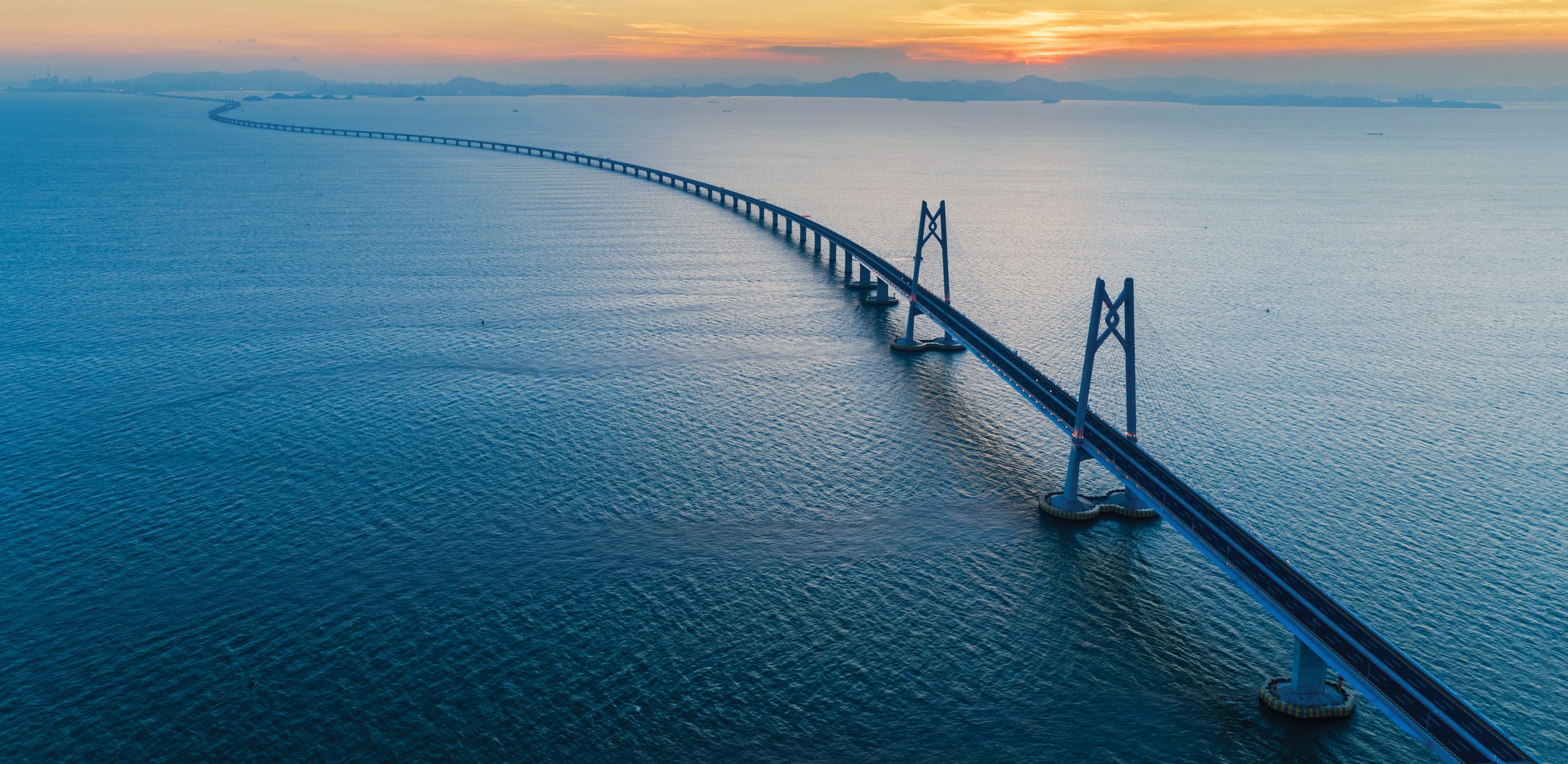

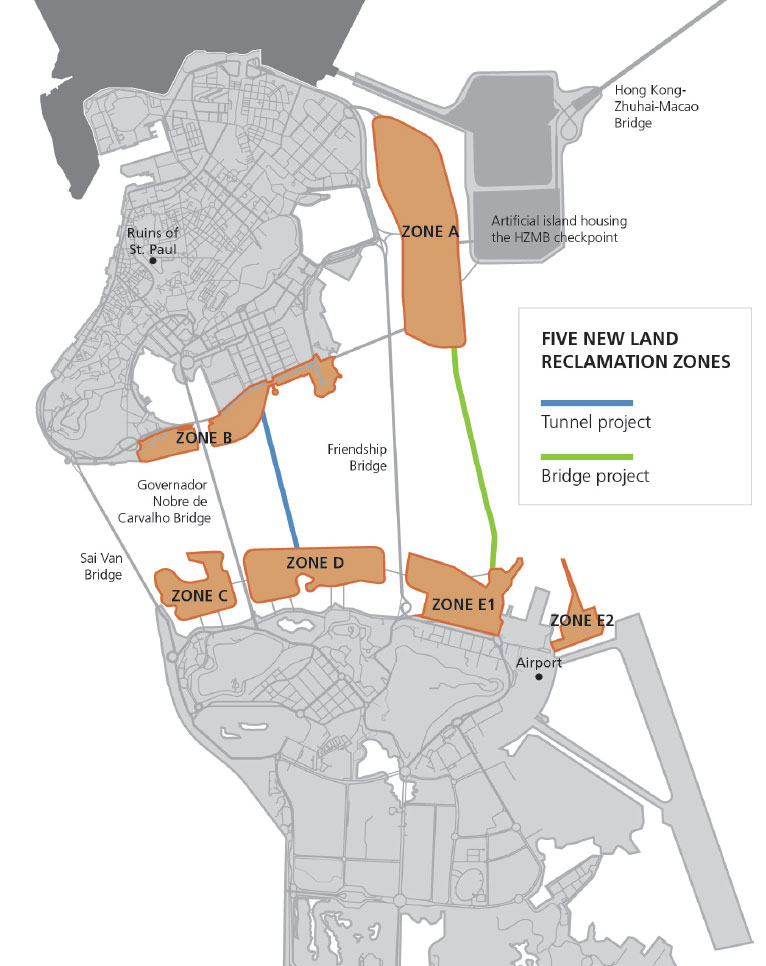
While the construction works in Barra Station have been accelerated and the Modal Transport Centre of Barra (or Barra Public Transport Interchange) – which sees different modes of transport coming together at one centre – is in the final stages of construction, works on the Sai Van Bridge to connect the LRT Taipa Line to the Macao peninsula are expected to begin later this year. The Barra Public Transport Interchange – a 35,957-square metre underground station and parking facility for coaches and private cars in Barra district – has been designed by local firm LBA Architecture and Planning. According to the ‘lines of government action for 2020’, the LRT connection to Barra should be concluded by 2023. The LRT Seac Pai Van Line will have a total length of 1.6 kilometres, covering the Islands District Medical Complex, which is under construction, and the Seac Pai Van public housing area. Some preliminary works have already started. The tender for the main structure’s construction works will open soon; however, the whole project is not expected to be completed until 2024.
On 20 April, the Chief Executive also announced that Macao will be linked, in the future, to the high-speed rail network in China following the construction of an underwater tunnel to the checkpoint on Hengqin Island, as part of the LRT’s development. The LRT system in Macao is expected to be connected to the Guangzhou-Zhuhai Intercity Mass Rapid Transit and from here to the Guangzhou-Zhuhai-Intercity Railway through Hengqin Station, which is set to become one of southern China’s major transport hubs. The Guangzhou-Zhuhai Intercity Railway will, over the next few years, be further extended from Hengqin Station to Zhuhai Airport, allowing for a faster connection from this China’s Mainland airport to Macao in the future, according to media reports. Hengqin is currently connected to Cotai via Lotus Bridge.
The future underground LRT extension line connecting the Cotai checkpoint, which is also known as the Lotus Flower checkpoint, to Hengqin Island in Zhuhai will have a total length of 2.2 kilometres, covering two stations – one in Macao and the other on Hengqin Island. The preliminary design of this task will be completed this year and the construction will be undertaken by a company or organisation from the Mainland, according to the ‘lines of government action for 2020’. The Lotus Flower checkpoint is also expected to be relocated from Cotai to the new Hengqin checkpoint, which has been partially under the jurisdiction of the SAR since 18 March. The relocation will allow the flow between the Mainland and the city to be reduced to a single border control and it will also help LRT passengers to connect to the high-speed rail network in Guangdong province.

On the subject of Hengqin Island, Ho Iat Seng, during his policy address, said it ‘would be a prominent platform for Macao to play an active part in the Guangdong-Hong Kong-Macao Greater Bay Area’. During the Legislative Assembly session, Ho noted Hengqin was a location that is convenient and appropriate in terms of Macao’s economic diversification efforts. The 106-square kilometre island is administratively part of Zhuhai but parts of it have been allocated to Macao to support the SAR’s development plans.
Other infrastructure plans set out by the government shortly after the Chief Executive’s policy address included the move ‘to implement construction of public housing in New Urban Zone Area A’ and to begin construction of 3,011 housing units. There was also a pledge to ‘commence reconstruction of certain facilities of the Taipa Ferry Terminal, which is to be integrated with the second passenger terminal at the city’s airport’ and ‘to conduct a public consultation before year-end on Macao’s urban development master plan’.
An important direction

The light rail extension to the Mainland, namely ‘through the entry of Zhuhai-Hengqin’ is ‘an important direction for the future development of Macao’, says Joe Eddie Wu. He also underlines that a ‘complete transportation system is inevitable to position Macao as a World Centre of Tourism and Leisure’. Pereira agrees, saying: “From the perspective of connectivity at the Greater Bay Area level, the LRT connection to Hengqin is especially relevant.” He adds that the LRT connections with Zone A and the HZMB artificial island that houses the boundary crossing facilities are equally important.
“With the extension of the Zhuhai Intercity Railway line to Hengqin,” says Pereira, “the connection with the Macao LRT will be significant in linking Macao to a GBA-level transportation network.” The Zhuhai transportation infrastructure development, which includes “a planned expansion of the Zhuhai Jinwan Airport” and an “increase in its capacity”, as well as “the Macao LRT connection with Zhuhai Intercity Railway in Hengqin”, will eventually impact Macao’s international airport (MIA), he says. Therefore, he adds, ‘the MIA will thus be subject to the compounded effects of these future railway and LRT links at Hengqin and Qingmao, the connection at Gongbei and the articulation of the Macao transportation network with the Hong Kong-Zhuhai-Macao Bridge’.
Pereira stresses that ‘complementarity is the way forward in this regard as far the MIA is concerned’ and he says that is ‘perfectly in line with the principles of co-operation laid out in the GBA Framework Agreement’, citing the framework: ‘achieve a win-win situation through complementary co-operation’. He stresses: “The Greater Bay Area has five international airports in close proximity. Co-operation is the only way forward.” Pereira also highlights that these road and railway systems shall be further complemented by ‘effective intermodal platforms guaranteeing smooth transitions between road, rail and air travel’. “This offers,” he says, “adequate linkage to the GBA transportation network at large, which is of the utmost importance for Macao to take advantage of due to the GBA’s possibilities.”

The Civil Aviation Authority of Macau (CAAM) is in charge of the ‘Macau International Airport Master Plan’, which began being drafted in 2010 and was approved in 2016 by Macao’s government. The plan anticipates that the future ‘closer co-operation among the cities’ in the GBA and the increased movement of people and the transport of cargo in the GBA ‘will bring about a higher demand for air transport’. Also, according to the plan, the operations of the MIA ‘have reached the maximum capacity’ and it is ‘therefore with an urgent need’ that the airport ‘must undergo expansion’. The document forecasts an increase in future air traffic and sets two development phases for the MIA to expand its capacity up to 11 million passengers a year between 2024 and 2026, going up to 15 million passengers a year between 2031 and 2037.
In August, the master plan and the MIA’s land reclamation application, which was adjusted to 1.49 square kilometres, was officially approved by China’s State Council, with instructions to proceed to the next stage of the airport expansion. The Environmental Protection Bureau, the Civil Aviation Authority and the airport concessionaire, Macau International Airport Co Ltd (CAM), are now working on a design plan of land reclamation at the site, as well as an environmental impact study and other necessary information that is required for the application for land reclamation, which should be ready in the second half of this year. It will then be submitted to the central government for approval. Meanwhile, the project to transform some of the facilities at the Taipa Ferry Terminal and to integrate the ferry terminal with the airport’s second passenger terminal should begin over the coming months.
Bridging the gap
Other transport infrastructure works are either being carried out in the city right now or are in the pipeline. As it stands, three bridges connect the peninsula of Macao with the island of Taipa. The first, the Governor Nobre de Carvalho Bridge, opened in 1974 and the second, known as Friendship Bridge, opened exactly 20 years later. In 2004, the grand Sai Van Bridge took its first vehicles but, within the next few years, it will no longer be the most recent. The fourth one will be built to the east of Friendship Bridge, linking the eastern part of the Zone A land reclamation area with the artificial island under the HZMB before passing over the outer port and the access channel to the inner port and ending in the Zone E1 land reclamation area next to Pac On in Taipa. A flyover will link the bridge with another future project, the Big Taipa Hill tunnel. According to the government, and as far as current plans are concerned, this tunnel would link the sea accesses, such as Friendship Bridge, to Cotai, allowing a faster access from the Macao peninsula and alleviating heavy traffic flows in the MIA and Taipa urban areas.
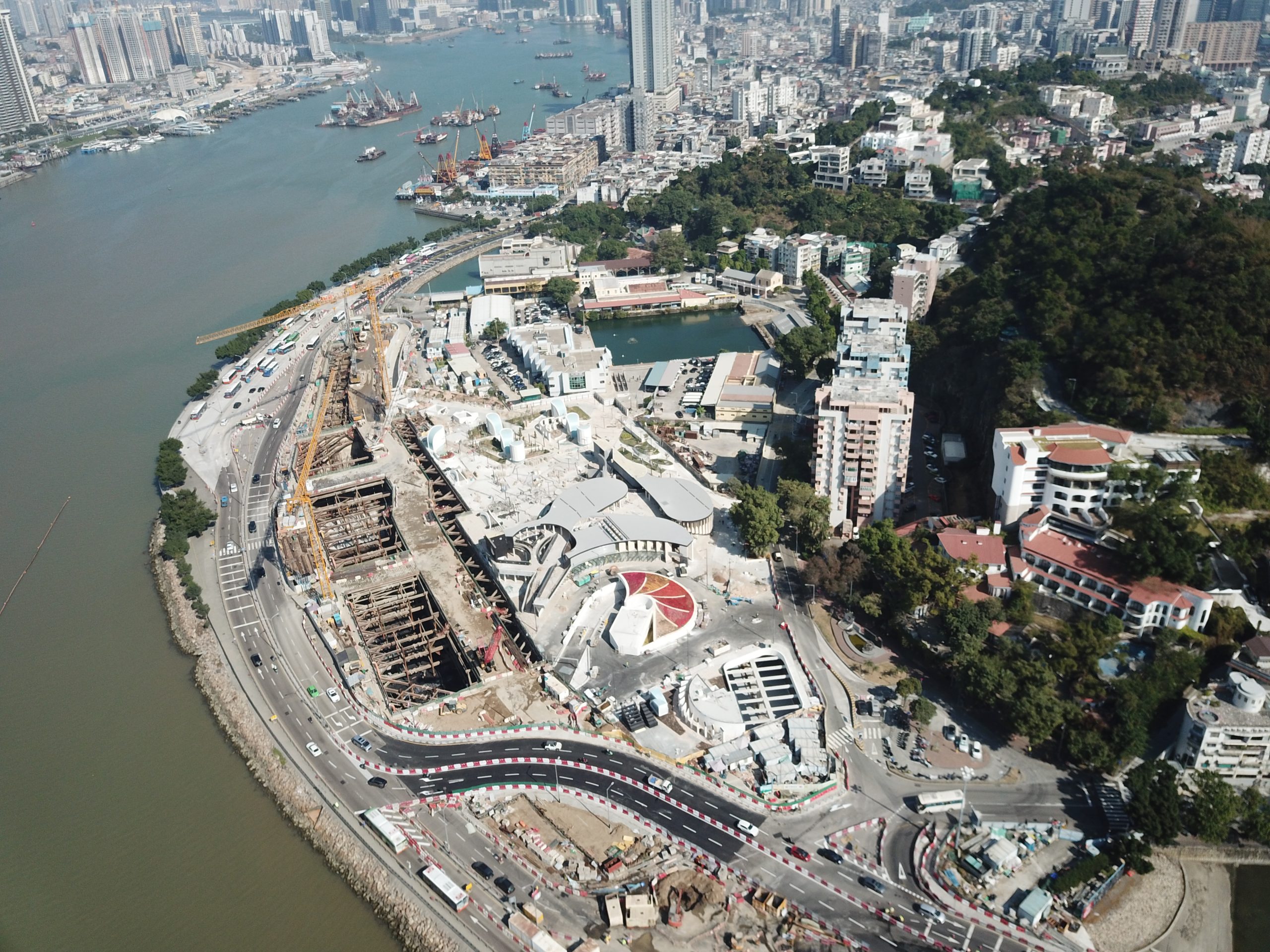
The fourth bridge will be about 3.6 kilometres long, with the section above the sea measuring about 2.9 kilometres in length. There will be four lanes in each direction – eight in total, with two of them for motorcycles only. Speed limits are expected to be 80 kilometres an hour along the highway and 40 kilometres an hour along the access ramps. Wind protection barriers will be installed to reduce the wind speed across the bridge – and that will help keep wind speeds down during typhoons which could prevent future accidents.
The first phase of the public tender to construct the bridge was launched in December 2018 and the evaluation process was completed in May last year. According to the government’s Infrastructure Development Office (GDI), seven bids were accepted in August and, following that, an MOP 5.2 billion (US$651 million) contract, with a completion date of 1,098 workdays, was awarded in December to a consortium composed of the China Civil Engineering Construction Corporation, the China Railway Construction Bridge Engineering Group Co Ltd and Omas Construction and Engineering Company Ltd for the bridge’s design and construction. Ove Arup and Partners Hong Kong Ltd is in charge of the project management and the LECM is responsible for quality control along with Macao’s Institute for the Development and Quality. The project is now pending the conclusion of a judicial process before construction can begin but works are expected to start later this year, according to the ‘lines of government action for 2020. The main works, including the bridge structure and flyovers, are expected to be concluded by 2024.
Going underground

The construction of Ka Ho Tunnel – a project that will link the east of Cotai to the northeastern tip of Coloane – is already well underway. It has so far been built by a consortium, made up of China Gezhouba Group No 2 Engineering Co Ltd and Zhu Kuan – Fomento Imobiliário Limitada, who were awarded the MOP 254.1 million (US$31.8 million) contract by the government. Two sections of the tunnel have already been completed – the main section was finished in November, according to the government’s Infrastructure Development Office (GDI), and the southern exterior section, which involved road widening and additional sewage and peripheral containment works, was completed in 2015. The final project for the tunnel – the northern section – is being constructed by Companhia de Construção Cheong Kong Ltd under a contract worth MOP 175.1 million (US$21.9 million). It is expected to be finished by the end of next year.
The main tunnel section is 500 metres long and lanes run in both directions, each one 20 metres wide and 10 metres high. Its northern entrance starts near the Rua de Central Termica de Coloane in eastern Cotai and connects to the area near Ka Ho Port, the northeastern tip of Coloane where the Macau Oil Terminal and the Macau Cement Manufacturing Co Ltd lie. According to the GDI, the project will facilitate access by residents from Ka Ho village and vehicles driving towards the Ka Ho Port Container Terminal and will allow for a significant reduction in both driving time – up to 15 minutes – and traffic load.
Beneath the waves
The government has also been doing studies on a fifth link between Macao and Taipa. Chinese state-owned company CCCC Highway Consultants received in 2018 an MOP 99.2 million (US$12.4 million) contract for the preliminary design, geotechnical survey and study of an underwater tunnel near the existing Governor Nobre de Carvalho Bridge, with an 800-day deadline granted for the project to be finished. Once complete, this project will lay the foundation for a future underwater tunnel connection that will be approximately 2.4 kilometres long, have three lanes in each direction and a speed limit of 60 kilometres an hour.
An environmental assessment report was carried out by the Shanghai Architectural Research, Design and Research Institute Co Ltd under a contract signed with CCCC Highway Consultants’ Macao branch – and that assessment, completed in three phases, has been successively made available for the public to view. According to the Land, Public Works and Transport Bureau (DSSOPT) the environmental impact that could be caused by the construction of the underwater tunnel on the surrounding area will be ‘temporary and reversible’ and could be reduced if appropriate measures are implemented. Studies regarding preliminary works are now underway and, after these are completed, preliminary designs are expected to be drawn up.
The road to sustainable development
All of these projects will undoubtedly ease traffic and create opportunities in Macao. But at a regional level, Joe Eddie Wu highlights the relevance of the development of the GBA for the future of Macao. He stresses that, despite the city’s rapid economic growth, ‘the scale of development is limited’ in Macao. “Therefore,” he says, “the government always encourages young people to seek opportunities outside. This is not only a slogan but also the future direction of sustainable development in Macao. However, Macao itself must have the corresponding infrastructure to accelerate the integration of the city into the Greater Bay Area.”

A mindset change is needed in Macao, according to Leão, when it comes to the GBA and the new transport projects. “It is important,” he says, “to understand that we are not isolated here in this small territory but we have an action area that comprises nine plus two cities. All these cities offer a wealth of possibilities, cutting edge industries, investment areas and know-how. There are so many interactions that we can have as part of a megalopolis of 100 million people who think as agents and actors of that megapolis.” The architect stresses the importance of ‘gradually stopping a village way of thinking where we are competing with each other within Macao’. The idea, he explains, is to understand ‘who our peers and our partners are – not only here in Macao but across the Pearl River Delta’. He adds: “As more relationships between the various cities develop, this need for accessibility and fast transport will naturally emerge.”
As more relationships between the various cities of the GBA develop, the need for accessibility and fast transport will naturally emerge.
Along with the projects that link Macao’s transport system to the neighbouring cities, the local urban transport system is ‘equally important’ when it comes to the development of Macao’s internal infrastructure, underlines Wu. “Macao is a small place with high traffic density,” he says, “and a new thinking is deemed necessary in road planning.” Pereira says that the new transport infrastructure projects ‘will have an impact at a general level, which will bring about important changes in traffic patterns’. He says that mobility can be further improved as the new reclamation zones, as well as Hengqin, are developed. Ultimately, he recommends, “infrastructure development should be defined ‘vis-à-vis’ with government policies concerning urbanism, transportation, the environment and tourism”.
Wu also emphasises that the development of ‘Macao’s future infrastructure should not only focus on transportation’. It should, in addition to achieving the positioning of Macao as a ‘World Tourism and Leisure Centre’, he says, also be designed ‘to improve the overall quality of life for residents’ and this includes, among other things, the expansion of urban living spaces, priority given to a range of industries as well as the gaming businesses and the reservation of land for green areas, public facilities and public housing.
There will undoubtedly be a new raft of transport infrastructure projects implemented in Macao over the coming years as the city connects further with the GBA. However, these bridge, tunnel, LRT and airport schemes that are happening right now – or are set to begin shortly – will surely improve the flow of traffic and people and ensure that the territory is in the best place possible to function effectively within the GBA in both the near and distant futures.
